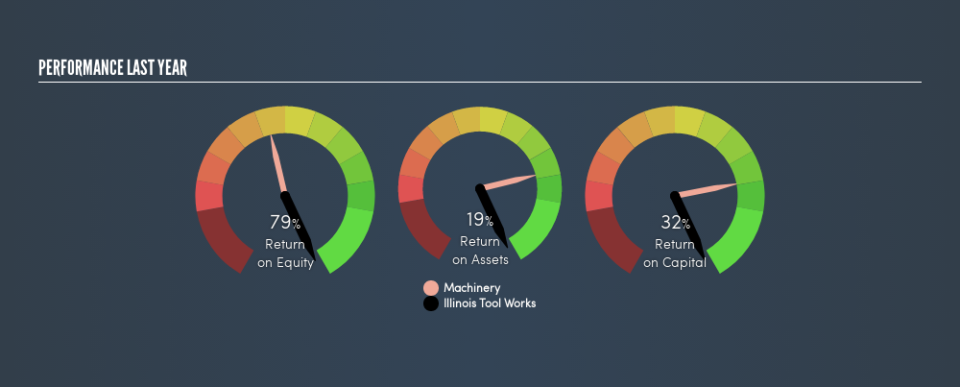A Close Look At Illinois Tool Works Inc.’s (NYSE:ITW) 32% ROCE

Want to participate in a short research study? Help shape the future of investing tools and receive a $20 prize!
Today we’ll look at Illinois Tool Works Inc. (NYSE:ITW) and reflect on its potential as an investment. To be precise, we’ll consider its Return On Capital Employed (ROCE), as that will inform our view of the quality of the business.
First of all, we’ll work out how to calculate ROCE. Next, we’ll compare it to others in its industry. Last but not least, we’ll look at what impact its current liabilities have on its ROCE.
What is Return On Capital Employed (ROCE)?
ROCE measures the ‘return’ (pre-tax profit) a company generates from capital employed in its business. Generally speaking a higher ROCE is better. Overall, it is a valuable metric that has its flaws. Renowned investment researcher Michael Mauboussin has suggested that a high ROCE can indicate that ‘one dollar invested in the company generates value of more than one dollar’.
How Do You Calculate Return On Capital Employed?
Analysts use this formula to calculate return on capital employed:
Return on Capital Employed = Earnings Before Interest and Tax (EBIT) ÷ (Total Assets – Current Liabilities)
Or for Illinois Tool Works:
0.32 = US$3.6b ÷ (US$15b – US$3.5b) (Based on the trailing twelve months to December 2018.)
So, Illinois Tool Works has an ROCE of 32%.
See our latest analysis for Illinois Tool Works
Is Illinois Tool Works’s ROCE Good?
When making comparisons between similar businesses, investors may find ROCE useful. Illinois Tool Works’s ROCE appears to be substantially greater than the 12% average in the Machinery industry. I think that’s good to see, since it implies the company is better than other companies at making the most of its capital. Setting aside the comparison to its industry for a moment, Illinois Tool Works’s ROCE in absolute terms currently looks quite high.
In our analysis, Illinois Tool Works’s ROCE appears to be 32%, compared to 3 years ago, when its ROCE was 21%. This makes us think about whether the company has been reinvesting shrewdly.
When considering ROCE, bear in mind that it reflects the past and does not necessarily predict the future. ROCE can be misleading for companies in cyclical industries, with returns looking impressive during the boom times, but very weak during the busts. ROCE is only a point-in-time measure. What happens in the future is pretty important for investors, so we have prepared a free report on analyst forecasts for Illinois Tool Works.
Illinois Tool Works’s Current Liabilities And Their Impact On Its ROCE
Liabilities, such as supplier bills and bank overdrafts, are referred to as current liabilities if they need to be paid within 12 months. The ROCE equation subtracts current liabilities from capital employed, so a company with a lot of current liabilities appears to have less capital employed, and a higher ROCE than otherwise. To counter this, investors can check if a company has high current liabilities relative to total assets.
Illinois Tool Works has total assets of US$15b and current liabilities of US$3.5b. Therefore its current liabilities are equivalent to approximately 24% of its total assets. A minimal amount of current liabilities limits the impact on ROCE.
What We Can Learn From Illinois Tool Works’s ROCE
With low current liabilities and a high ROCE, Illinois Tool Works could be worthy of further investigation. Of course, you might find a fantastic investment by looking at a few good candidates. So take a peek at this free list of companies with modest (or no) debt, trading on a P/E below 20.
If you like to buy stocks alongside management, then you might just love this free list of companies. (Hint: insiders have been buying them).
We aim to bring you long-term focused research analysis driven by fundamental data. Note that our analysis may not factor in the latest price-sensitive company announcements or qualitative material.
If you spot an error that warrants correction, please contact the editor at editorial-team@simplywallst.com. This article by Simply Wall St is general in nature. It does not constitute a recommendation to buy or sell any stock, and does not take account of your objectives, or your financial situation. Simply Wall St has no position in the stocks mentioned. Thank you for reading.

